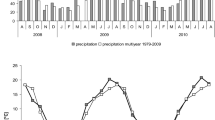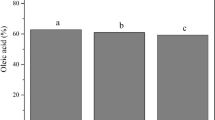Abstract
We studied the chemical composition of autumnal rosette leaves of winter rape hybrid Kasimir in stands of different density and its influence on plant wintering. The average duration of winter wheat growth in autumn was 95.7 days. For this period, rape accumulated 24.7% of dry weight in rosette leaves and 29.7% of dry weight in a terminal bud, whereas the sum of active temperatures was 857.3 °C . The content of dry matter, protein, and sulfur increased with increased crop density. In contrast, the total content of sugars, lipids, potassium, and phosphorus decreased. Tight correlations were observed between crop density and total sugar content (r = −0.877) and between crop density and the N/K ratio (r = 0.920) in the terminal bud. Rape overwintering depended directly on the total level of sugars in the leaves of autumnal rosette (r = 0.684) and in the terminal bud (r = 0.720) and on the lipid content in leaves (r = 0.623) and terminal bud (r = 0.832). The winter rape hybrid overwintered best in stands of low density (21–40 plants/m2) (r = –0.900). Changes in the protein composition in tissues of developing inflorescence and root collar (the appearance of novel proteins, dehydrins in particular, and disappearance of some other proteins) under the influence of auxin-like compounds TA-12 and TA-14 are one of the principal biochemical characteristics of oilseed rape cold hardening.
Similar content being viewed by others
Abbreviations
- ESP:
-
easily soluble proteins
- HSP:
-
hardly soluble proteins
- LUA:
-
Lithuanian University of Agriculture
REFERENCES
Cramer, N., Raps: Anbau und Verwertung, Stuttgart: Ulmer, 1990.
Gaveliene, V., Novickiene, L., Miliuviene, L., Pakalniskye, L., and Brazauskiene, I., Relationship of Rape Growth and Crop Production with Plant Growth Regulators and Disease, Vagos: mokslo darbai, 2002, no. 56, pp. 7–11.
Knittel, H., Winterraps, der Schwefelfresser, Raps, 2000, vol. 18, pp. 30–31.
Thomashow, M.F., Plant Cold Acclimation: Freezing Tolerance Genes and Regulatory Mechanisms, Annu. Rev. Plant Physiol. Plant Mol. Biol., 1999, vol. 50, pp. 571–599.
Sidlauskas, G., Ziemini ir vasarini rapsu (Brassica napus L.) vystymosi ir derliaus formavimosi rysiai su aplinkos veiksniais. Habilitacinis darbas (Relationship between Development and Yield of Winter Rape (Brassica napus L.) and Environmental Factors), Dotnuva: Akademija, 2000.
Velicka, R., Rapsai (Rape), Kaunas: Lutute, 2002.
Makowski, N., Zur Sortenspezifischen Anbautechnik von Qualitatsraps, Feldwirtschaft, 1986, no. 27, pp. 271–273.
Holmes, M.R.J., Nutrition of the Oilseed Rape Crops, London: Appl. Sci. Publ., 1980.
Browse, J. and Xin, Z., Temperature Sensing and Cold Acclimation, Curr. Opin. Plant Biol., 2001, vol. 4, pp. 241–246.
Thomashow, M.F., Role of Cold-Responsive Genes in Plant Freezing Tolerance, Plant Physiol., 1998, vol. 118, pp. 1–7.
Hughes, M.A. and Dunn, A.M., The Molecular Biology of Plant Acclimation to Low Temperature, J. Exp. Bot., 1996, vol. 296, pp. 291–305.
Novickiene, L., Rakleviciene, D., and Kazlauskiene, D., Physiological Analogues of Auxin: Effect on In Vitro Morphogenesis of Rape, Proc. Latvian Acad. Sci., 2000, vol. 55, pp. 201–206.
Jeknic, Z. and Chen, T.H.H., Changes in Protein Profiles of Poplar Tissues during the Induction of Bud Dormancy by Short-Day Photoperiods, Plant Cell Physiol., 1999, vol. 40, pp. 25–35.
Close, T.J., Dehydrins: A Commonalty in the Response of Plants to Dehydration and Low Temperature, Physiol. Plant., 1997, vol. 100, pp. 291–296.
Merkys, A. and Anisimoviene, N., Frost Resistance in Plants and Methods of Its Study, Sod. ir darz., 1998, vol. 17, pp. 29–38.
Welling, A., Kaikuranta, P., and Rinne, P., Photoperiodic Induction of Dormancy and Freezing Tolerance in Betula pubescens. Involvement of ABA and Dehydrins, Physiol. Plant., 1997, vol. 100, pp. 119–125.
Tumanov, I.I., Physiological Mechanisms of Plant Frost-Resistance, Fiziol. Rast. (Moscow), 1967, vol. 3, pp. 520–537 (Sov. Plant Physiol., Engl. Transl.).
Dagys, J., Bluzmanas, P., and Putrimas, A., Determination of Sugars by Bertran Method, Augalu fiziologijos laboratoriniai darbai (Laboratory Methods of Plant Physiology), Vilnius: Mintis, 1965, pp. 166–170.
Merkys, A., Novickiene, L., Miliuviene, L., and Saltyte, Z., New Growth Regulators and Evaluation of Their Physiological Activity: 2. Analogs of Auxin, Biologija, 1993, no. 4, pp. 54–58.
Safonov, I.I. and Safonova, M.P., Extraction of Proteins from Vegetative Organs of Plants for Electrophoretic Investigations, Fiziol. Rast. (Moscow), 1969, vol. 16, pp. 165–200 (Sov. Plant Physiol., Engl. Transl.).
Shulyakovskaya, T.A. and Anisimovene, N.A., Protein Composition of Pinus sylvestris Buds during Various Growth Periods, Lesovedenie, 1985, vol. 6, pp. 64–70.
Bradford, M.M., A Rapid and Sensitive Method for the Quantitation of Microgram Quantities of Protein Utilizing the Principle of Protein-Dye Binding, Anal. Biochem., 1976, vol. 72, pp. 248–254.
Anisimoviene, N., Merkys, A., Jodinskiene, M., and Mockeviciute, R., IAA-Protein Complexes in Different Compartments of Dicotyledonous Plant Cells, Sod. ir darz., 2000, vol. 19, pp. 86–97.
Arora, R., Rowland, L.J., and Panta, G.R., Chill-Responsive Dehydrins in Blueberry: Are They Associated with Cold Hardiness or Dormancy Transitions? Physiol. Plant., 1997, vol. 101, pp. 8–16.
Author information
Authors and Affiliations
Additional information
__________
Translated from Fiziologiya Rastenii, Vol. 52, No. 4, 2005, pp. 532–539.
Original Russian Text Copyright © 2005 by Velicka, Rimkeviciene, Novickiene, Anisimoviene, Brazauskiene.
Rights and permissions
About this article
Cite this article
Velicka, R., Rimkeviciene, M., Novickiene, L. et al. Improvement of Oil Rape Hardening and Frost Tolerance. Russ J Plant Physiol 52, 473–480 (2005). https://doi.org/10.1007/s11183-005-0070-1
Received:
Issue Date:
DOI: https://doi.org/10.1007/s11183-005-0070-1




